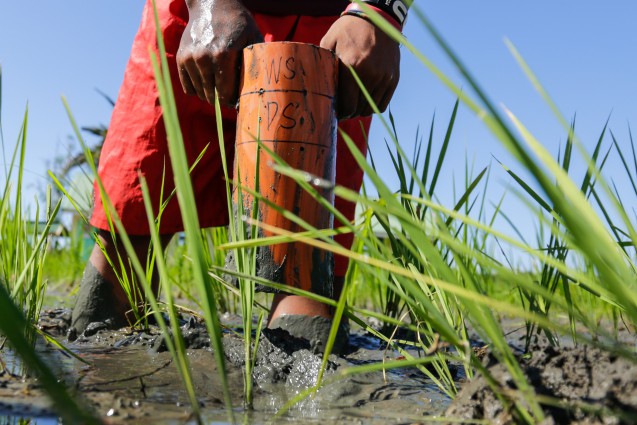The restlessly rising fuel prices will hit the few farmers who are dependent on pumps for irrigation. They will breathe deeply, exhale slowly, and scratch their heads. They will probably forget the name of their patron saints for a while. The alternate wetting and drying (AWD) technology could help them lighten this burden.
Saving on water
AWD is a water-saving technology that rice farmers could adopt to reduce their use of irrigation water without penalizing crop yield.
According to PhilRice engineer Kristine Pascual, this technology for lowland rice farmers could help save on water by up to 50%, if properly implemented.
“Water saved can be used to irrigate farms at the tail-end of the service area. Rice farms dependent on supplemental irrigation sources like shallow tube well would also benefit from this technology,” Pascual said.
AWD technology comes with an observation well that helps farmers to monitor the water table until the root zone during the tillering to pre-flowering stages of the rice plant. Use of the observation well must be suspended during fertilizer application to enhance the plants’ nutrient-uptake efficiency and prevent flower sterility.
Also, experts contend that AWD could reduce emissions of greenhouse gases and increase the number of productive tillers, resulting further in more filled grains per panicle.
Cutting on cost
Mario M. Ermita, 51, from Masinloc, Zambales testified that AWD is a farming ally as it helped him save on fuel use by up to 25%. “
Prior to my use of AWD technology in 2016, I spent P8,000/ha for diesel from planting to harvesting. With AWD, I saved about P2,000/ha. Honestly, I was surprised with the result,” he shook his head.
Mario’s experience spreads like wildfire. Eight farm operators adopted the AWD technology after hearing his story.
Meanwhile, the use of pumps for irrigation was reduced in Mallig, Isabela with the advent of AWD technology.
Igmedio Ventura, 49, was still in awe when his diesel consumption in a hectare per cropping season tremendously dipped from 500L to 300L.
“For pump-dependent farmers, I can attest that AWD saves 50% on labor cost. Instead of hiring a pump operator twice a week, I only have to hire once weekly,” Igmedio enunciated.
In Bulacan, officers and members of the Kapatiran Irrigators’ Association (KIA) were satisfied with the technology. Before, they used electricity to run their pumps. AWD decreased power cost by 7% in 2015 – from 118,178 kW/h electric consumption in 2014, to 109,660 kW/h. That’s about P160,000 worth of savings.
Attesting to the advantage of using AWD technology, Thelma Mallari of the National Irrigation Administration Bulacan said that they managed to irrigate an additional 15ha with the AWD-saved water. KIA now sustains a total of 200ha of rice fields using AWD technology.
Automated water monitoring
Researchers are now working on a decision support tool called Automated monitoring (AutoMonPH), which is based on the principle of AWD that rationalizes water-use and management.
AutoMonPH provides continuous realtime monitoring and reporting of water status in the field. It even transmits information automatically from the field to the central database that can be utilized by irrigation managers as reference for water demand at a landscape level.
It can also send alerts to farmers’ mobile phones about the water level in the field, which is useful in coming up with irrigation schedules. This technology is being developed under the IRRI-PhilRice WateRice project.
Indeed, AWD helps wash away some of the anxieties that farmers, especially the pump-dependent ones, have after the enactment of TRAIN Law.





